In January 2015 two new mobile radio sites appeared in Sand Spring Valley near Rachel and in Railroad Valley. We first reported these sites on January 17, 2015. They are clearly experimental in nature and were first used during Red Flag 15-1.
The sites provide high speed 2.4G WiFi and integrate with aircraft telemetry data and possibly voice in the UHF air band (225-400MHz) and with telemetry data from the Nellis Air Combat Training System (ACTS, 1755-1850 MHz). The connection to the command center is a microwave link to Cedar Peak in the NATO segment of the C-Band (4.4-5.0 GHz). Cedar Peak is the main hub in the northern NTTR of the Nellis Digital Microwave Communication System (NDMCS).
The sites tend to appear just before Red Flag or other exercises, and are towed back to TTR, sometimes for modifications, after the exercise or mission has ended.
The Rachel site is located on public land, next to a well traveled dirt road and not far from the highway. It is surrounded by concrete barriers for protection. The main components of the site are an extendable antenna tower, a power generator and a fuel tank.
A second site in Railroad Valley used solar panels and a battery pack for a power source instead. It has not been seen in several years. Both sites are experimental in nature and we can assume that the set-up with the generator proved to be a better option.
The Rachel site is mounted on a trailer. After going through some modifications the site is now entirely self-contained on a light trailer that can easily be moved. Most likely one of the parameters in the design and test of the site is the ability to easily be deployed in the field. In 2016 a yagi antenna was added, also directed at Cedar Peak. Since then the site appears to be operated remotely without any personnel on site. The new antenna is likely a remote control receiver to turn the site on and off.
The site appears to be designed to network the command center to various types and generations of aircraft and to ground units such as mobile SAM sites. Newer mobile systems rely heavily on networked virtual reality components for situational awareness, telemetry data etc. However, the various systems are not always designed to talk to each other. The new radio site appears to be a test platform for newly developed, field deployable communication hubs. It integrates the various data and communication networks with each other and with the command and control center via fast microwave link. As mentioned above the final site is designed for easy deployment in the battlefield as needed as well as possibly for integration in airborne platforms.
Without going into too much detail, the site includes the following antennas:
Microwave panel on the side: Full-duplex Ethernet data link to Cedar Peak in the 4.4-5.0 GHz band.
Cluster of four omni-directional antennas at the top: 2.4G WiFi link to mobile ground and possibly air units in the 2,400-2,500 MHz ISM band. The range of the system is up to 100 miles with no need for line-of-sight.
Gray omni-directional antenna on the side: Full duplex link to mil air comms and data in the 225-400 MHz band.
Black omni-directional antenna on the side: Simplex 1755-1880 MHz link to the Nellis ACTS system, most likely for aircraft telemetry data.
Small black directional yagi antenna: Pointed in the same direction as the microwave panel. It is likely connected to an always-on receiver that remotely turns the site, including the generator, on and off as needed. The remote control operates in the 902-960 MHz band.
In addition the site includes a weather station and security features, including a 360 degree security camera and motion sensors.
History:
January 2015: Sites were first installed near Rachel and in Railroad Valley
Late 2015: The original WiFi antennas at the top of the site, three panels similar to a cell site configuration, were replaced with a single omni-directional antenna
2016: Remote control was added to the Rachel site
05/2019: The microwave panel of the Railroad Valley site that was pointed to the Ragged Ridge Ethernet backbone relay has been removed. Only the omni directional antenna on top of the tower remains. It is possible that due to the short distance to Ragged Ridge and improvements to the system the directional high-gain panel is no longer needed for the Ethernet data link to the backbone. The site still appears to be in use.
09/2019: The Rachel site was removed before the Alienstock event.
11/2019: The Rachel site was back and running in the same configuration as before. Only the external electrical junction box that originally provided power from an external generator is gone. The site is now entirely powered by the integrated 7kW Whisperwatt generator.
Around 2020: The Railroad Valley site disappeared.
02/2023: The Rachel site was gone for a while. When it showed up again for Red Flag 24-1 the single omni directional WiFi antenna at the top had been replaced with a cluster of four high gain omni directional antennas that operate in the 2.4 GHz WiFi band (2,400-2,500 MHz). The Railroad Valley site is still missing.
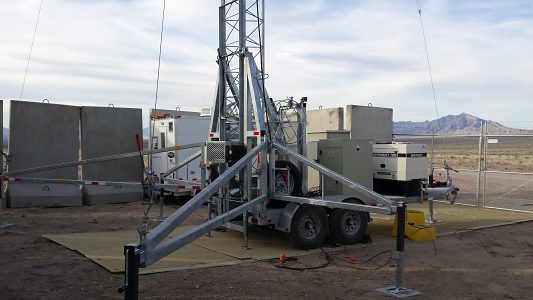 Base of the Rachel site; it is powered by a Whisperwatt 7000 generator |
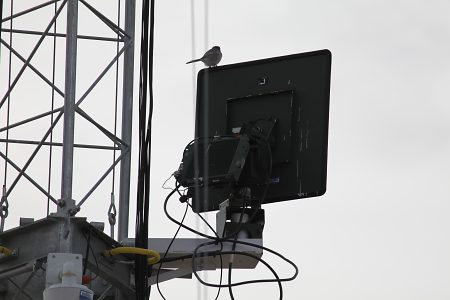 Microwave panel of the Rachel site, pointed at Cedar Peak, operating in the 4.4-5.0 GHz band |
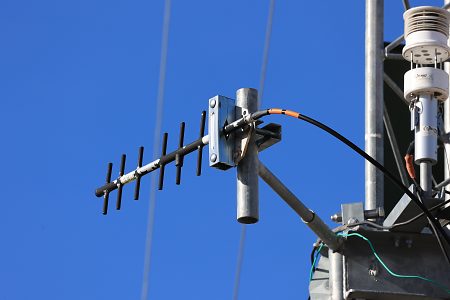 10 dB Yagi antenna pointed at Cedar Peak for remote control, operating in the 902-960MHz band |
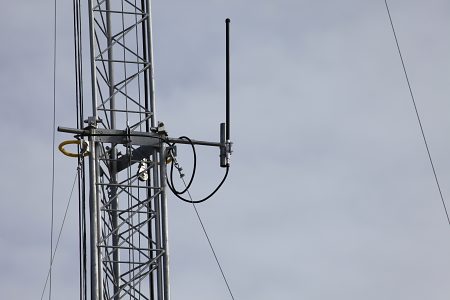 Omni directional antenna for ACTS telemetry data in the 1755-1850 MHz band |
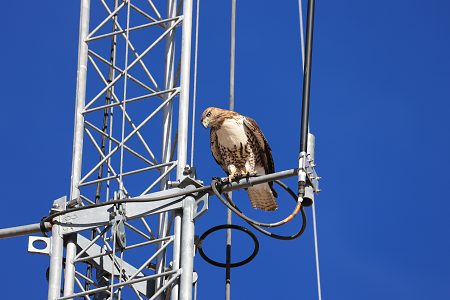 The guardian of the site |